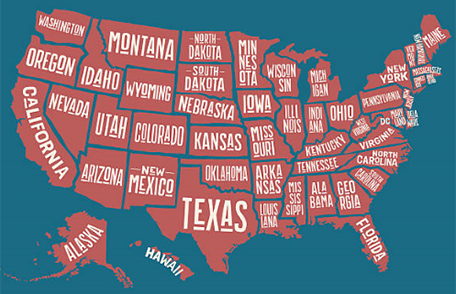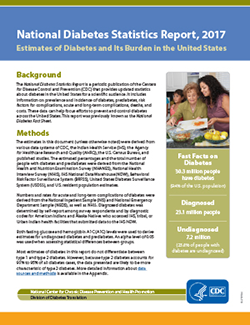National Diabetes Statistic Report, 2017

Diabetes cases are beginning to level off, but the number is still enormous: more than 100 million people in the United States have diabetes or prediabetes. Much work still needs to be done.
In July, CDC’s Division of Diabetes Translation (DDT) released the National Diabetes Statistics Report, 2017. The report presents the “state of the disease” in our nation, providing the most recent scientific data on:
- Diabetes incidence (new cases)
- Diabetes prevalence (existing cases)
- Short- and long-term complications
- Risk factors for complications
- Prediabetes
- Mortality (death rate)
- Costs
Diabetes is a serious disease that can often be managed through physical activity, diet, and use of insulin and oral medications to lower blood sugar levels. People with diabetes are at increased risk of additional serious health complications including vision loss, heart disease, stroke, kidney failure, amputation of toes, feet or legs, and premature death. As many as 2 out of 5 Americans are expected to develop type 2 diabetes in their lifetime.
Prediabetes is a serious health condition in which a person’s blood sugar levels are higher than normal but not high enough yet to be classified as type 2 diabetes. Without weight loss (for those who need it), healthy eating, and moderate physical activity, many people living with prediabetes will go on to develop type 2 diabetes.

The National Diabetes Statistic Report provides the most recent scientific data on prediabetes, new cases of diabetes, risk factors for complications, and much more.
The National Diabetes Statistics Report, 2017 analyzes health data through 2015, providing statistics across ages, races, ethnicities, education levels, and regions. This report reflects a point-in-time analysis, and its data provides vital perspective on the current status of diabetes and can help focus prevention and control efforts going forward. Key findings:
- 30.3 million Americans—nearly 1 in 10—have diabetes.
- 84.1 million American adults—approximately 1 in 3—have prediabetes.
- Over half of new diagnosed diabetes cases were in adults 45-64 years old.
- New diagnosed cases of type 1 and type 2 diabetes have increased among US youth.
- New diabetes cases were higher among non-Hispanic blacks and Hispanics than non-Hispanic whites.
- For US adults diagnosed with diabetes, prevalence was highest among American Indians/Alaska Natives.
- Nearly 16% adults diagnosed with diabetes were smokers, nearly 90% were overweight, and more than 40% were physically inactive.
Youth data was provided from SEARCH for Diabetes in Youth Study, the nation’s first and only ongoing assessment of trends in type 1 and type 2 diabetes among youth—led by CDC and supported by the National Institutes of Health. The study’s findings are key to understanding how the epidemic is changing over time in Americans under 20 years old.
More people are developing diabetes during youth, and racial and ethnic minorities continue to develop this condition at higher rates. Likewise, the proportion of older people in our nation is increasing, and older people are more likely to have a chronic disease like diabetes. It’s critically important that efforts are intensified to control and manage diabetes and prevent type 2 diabetes. And by addressing diabetes, many other related health problems can be addressed and/or prevented.
What CDC Is Doing
Through the Division of Diabetes Translation, CDC is working to reverse the epidemic by helping to identify people with prediabetes, prevent type 2 diabetes and the complications of diabetes, and improve the health of all people with diabetes:
- The CDC-led National Diabetes Prevention Program (National DPP) enables people with prediabetes to participate in an affordable, high-quality lifestyle change program to prevent type 2 diabetes and improve their overall health. Participants learn to make healthy lifestyle changes that can cut their risk of type 2 diabetes by as much as 58% (71% if they’re over 60). Currently, more than 1,400 CDC-recognized organizations offer the National DPP lifestyle change program, and those that have submitted data report more than 100,000 eligible participants. Approximately 65 commercial health plans provide some coverage for the program, and Medicare will start to reimburse for CDC-recognized programs in 2018.
- CDC partnered with the American Diabetes Association, American Medical Association, and Ad Council to launch the first national prediabetes awareness campaign. Humorous public service announcements in English and Spanish are reaching millions of people who may be at risk for prediabetes and encouraging them to take a short test at DoIHavePrediabetes.org.
- CDC has joined forces with CBS Television Stations in a TV and digital mini-series to provide crucial information about diabetes. Host Joan Lunden and CDC’s Dr. Ann Albright share insights on prediabetes, risk factors, managing diabetes, preventing or delaying type 2 diabetes, and more.
Visit the DDT website for more information about how the division is translating science into practice to realize its vision: a world free of the devastation of diabetes.
- Page last reviewed: August 8, 2017
- Page last updated: August 8, 2017
- Content source:
- National Center for Chronic Disease Prevention and Health Promotion, Division of Diabetes Translation
- Page maintained by: Office of the Associate Director for Communication, Digital Media Branch, Division of Public Affairs




 ShareCompartir
ShareCompartir